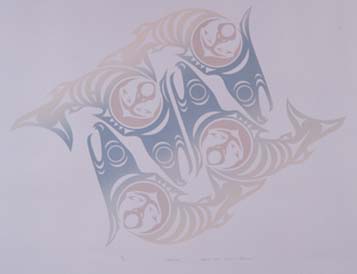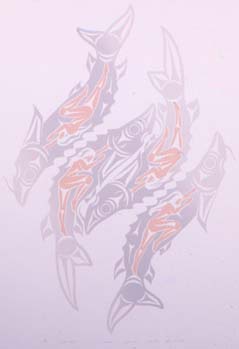Images About the Graphics Collection About This Site
Resources for Further Information Links



| Kwantlen
08/83 Susan A. Sparrow Edition: 72/100 Silkscreen © Copyright 1983 Susan A. Point. All Rights Reserved. |
Sturgeon
06/85 Susan A. Point Edition: 3/55 Silkscreen © Copyright 1985 Susan A. Point. All Rights Reserved. |
Experimentation has been an important part of Susan Point's work from very early on in
her career. In these two images, the artist moves away from the circular confines of
the spindle whorl, creating instead free flowing compositions comprised of repeated
images of fish. A College of the same name, located in British Columbia, originally
commissioned the design for Kwantlen. In the print, the arcing bodies of four salmon,
shown in profile, create a puzzle-like pattern with the heads of the fish all pointing
toward the center of the composition, while their fins and tails delineate the boarder.
The human face each fish contains in the center of its body echoes the fish's round
eyes and open mouth. This incorporation of the human face recalls the imagery of spindle
whorls, thus alluding to a traditional Coast Salish element within a very non-traditional
composition.
Sturgeon, a later variation on this composition, depicts a horizontal
stacking of arcing sturgeon. Instead of repeating the human face seen in Kwantlen,
Susan incorporates a female figure into the center of each fish. A legend referring
to the transformation of a woman into a sturgeon was the artist's inspiration for this
design innovation (Karen Duffek, p. 5). While she experiments with her subject matter, Point remains
constant in her use of a Coast Salish design vocabulary. The now familiar trigons
and crescents are used throughout the image to articulate the bodies of the women
and the fish. Equally recognizable in both prints are Susan's characteristically
fluid lines and her balanced juxtaposition of negative and positive space. An
undulating sense of motion is the result of Susan's unique style in both works.
Reflecting on Sturgeon in a 1986 discussion with Karen Duffek, Point says: "The design
is swaying away from traditional Salish art. It is free flowing, and the figure of
the woman inside the sturgeon was my own invention. I think Indian artists shouldn't
be restricted to doing traditional pieces all the time. It's time to move on."
| BACK | NEXT |
